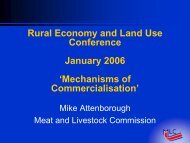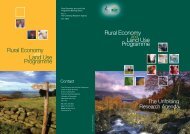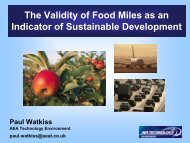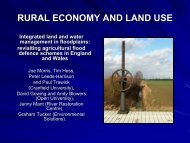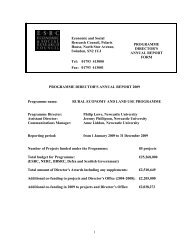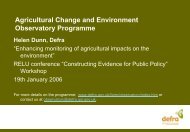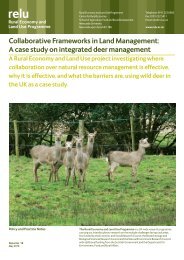Future Society in 2024: 21st Century 'Good Life' - Rural Economy ...
Future Society in 2024: 21st Century 'Good Life' - Rural Economy ...
Future Society in 2024: 21st Century 'Good Life' - Rural Economy ...
Create successful ePaper yourself
Turn your PDF publications into a flip-book with our unique Google optimized e-Paper software.
Economic: Deep rural areas are surpris<strong>in</strong>gly economically vibrant given their low population<br />
densities. This is <strong>in</strong> part due to their success <strong>in</strong> attract<strong>in</strong>g tourists and ‘day/weekend breakers’, as<br />
ev<strong>in</strong>ced from the high number of hotels and restaurants <strong>in</strong> these areas. In an ever more complicated<br />
world deep rural areas offer the prospect of tranquillity that even other rural areas do not. In<br />
addition, deep rural areas are attractive to rural entrepreneurs, and can potentially become ‘dynamic<br />
rural’ areas (see below) – as Cambridgeshire has become.<br />
Social: The social structure of deep rural areas is likely to ‘gentrify’ <strong>in</strong> future years; there will be<br />
greater delocalisation due to widened car ownership and the mobility of newcomer groups.<br />
Technological: The lack of technological <strong>in</strong>frastructure <strong>in</strong> deep rural areas is a substantial barrier to<br />
the relocation of more rural enterprises <strong>in</strong>to these areas. However it will not <strong>in</strong>hibit the attraction of<br />
these areas to domestic and <strong>in</strong>ternational tourists.<br />
E. ‘Retirement retreats’ (’Sea scape Brita<strong>in</strong>’)<br />
Overview<br />
With<strong>in</strong> this typology there is a complex relationship between the asset rich/asset poor and the<br />
active/<strong>in</strong>active. This produces quite different trajectories for different areas – some have become<br />
depressed and isolated, while others have become more energetic and politically active.<br />
The wealthier areas have become more welcom<strong>in</strong>g to migrant workers to fill the big service gap. The<br />
migrant workers are attracted by the economic opportunity. There are also many gay couples and<br />
‘young fogies’ <strong>in</strong> the area, drawn by the kid free nature of the area and the appeal of the sea<br />
air/view. The bulk of the population consists of retired pensioners of the baby boom generation.<br />
In the less wealthy areas, there are <strong>in</strong>creas<strong>in</strong>g problems of social exclusion, caused by lack of<br />
personal <strong>in</strong>come and lack of public services.<br />
The key drivers that have affected the lives of the people described above are: service access etc.<br />
Political: Pensions policy is the one area that will substantially impact upon <strong>in</strong>comes of the<br />
<strong>in</strong>habitants of this typology. Present policy is oriented towards marg<strong>in</strong>aliz<strong>in</strong>g the role of state<br />
pension as a pillar of pension support. <strong>Future</strong> retirees <strong>in</strong> <strong>2024</strong> may however possess adequate private<br />
pension sav<strong>in</strong>gs as well as assets (e.g. stored <strong>in</strong> the value of their homes) that will tide them<br />
through their retirement years.<br />
Economic: The economic structure of these areas is and <strong>in</strong> future will even more so be driven by<br />
retirement-related services such as health services and social care. This, obviously, is due to the high<br />
proportion of retirees among the population of this typology. Average <strong>in</strong>comes <strong>in</strong> retirement retreat<br />
areas are low but may rise <strong>in</strong> future, given that demand for coastal retirement dest<strong>in</strong>ations will<br />
<strong>in</strong>crease as the baby-boom generation enters retirement and this will push up prices along the<br />
Southern coast, mak<strong>in</strong>g them more socio-economically exclusive.<br />
Social: The community capacity <strong>in</strong> retirement retreat areas is relatively vibrant due to the<br />
composition of its <strong>in</strong>habitants, who have greater time to devote to community and social activities.<br />
Retirement retreat areas have fairly high population densities and this will help to ma<strong>in</strong>ta<strong>in</strong> the<br />
viability of local services. In addition, present social trends <strong>in</strong>dicate that there will be more s<strong>in</strong>gleelderly<br />
households <strong>in</strong> 20 years time. However this fact may equally <strong>in</strong>crease, rather than decrease,<br />
the strength of civil society <strong>in</strong> these areas.<br />
As the baby-boom generation enters retirement over the course of the com<strong>in</strong>g decade the number of<br />
retirees <strong>in</strong> the UK will <strong>in</strong>crease and of those a sizeable number can be expected to relocate to coastal<br />
areas.<br />
73



